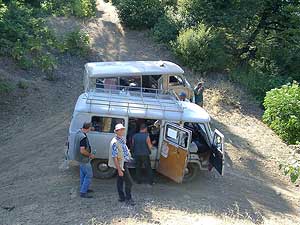|
July 10, 2002
Western Australian researchers
surveying the hostile landscapes of Turkmenistan have returned
the first new weapons intended for use in Australian
graingrowers’ battle with salinity.
Formerly a Soviet state,
Turkmenistan is still establishing its international borders and
its agriculture is limited to nomadic cattle grazing and oasis
centred cotton cropping.
 However,
Australian researchers, with support from the
Grains Research and Development
Corporation (GRDC), have been scouring Turkmenistan’s acidic
and saline soils to capture perennial legume germplasm to
broaden the management options available to Australian
graingrowers threatened by salinity. However,
Australian researchers, with support from the
Grains Research and Development
Corporation (GRDC), have been scouring Turkmenistan’s acidic
and saline soils to capture perennial legume germplasm to
broaden the management options available to Australian
graingrowers threatened by salinity.
"In Australia, perennial legumes
rotated with cereal crops are helping absorb moisture from lower
in the soil profile and are therefore slowing the rise of saline
watertables," said John Howieson, GRDC project supervisor and
Director of the Centre for Rhizobium Studies (CRS) at WA’s
Murdoch University.
"However, lucerne has been the
primary perennial legume used to control recharge and its
performance wavers on acidic soils, leaving growers short of
options. This is a particular problem in significant parts of
Western Australia, Victoria and New South Wales.
"Commonly used legumes in
Australia, such as lucerne, come from the Mediterranean basin
and there has been limited exploration of alternative sources
which could harbour better suited varieties," he said.
With GRDC support, Associate
Professor Howieson, in association with international
collaborators, therefore launched a global search of comparable
environmental systems to find new perennial options for
Australian growers.
"Kevin Foster and Peter Skinner
of the WA Department of Agriculture have been moving across
Turkmenistan in make-shift camps, hunting their own food and
enduring 45 degree Celsius heat to accumulate new legume
material," he explained.
"They have collected 413
promising legume accessions from 48 sites and, importantly, have
already sent back nodule and soil extracts from those sites for
sampling at CRS."
Root nodule/soil interactions
generate the nitrogen fixation which makes legumes so valuable
to farming systems. Examining the Turkmenistan samples will help
CRS develop rhizobia inoculants to ensure imported germplasm can
perform in Australia.
According to the scientific GRDC
Western Regional Panel Member responsible for Sustainable
Farming Systems, Robert Belford, these efforts will permit
comprehensive evaluations of new germplasm that could empower
growers with a range of new recharge management options.
"The project focuses on acid
tolerant perennial legume species, Trifolium and Lotus, because
they could increase the viability of growers fighting salinity
on acidic soils.
"Effectively, the GRDC’s
international collaboration efforts help Australian scientists
look on the other side of the fence to see if the grass is
greener and, if it is, to bring the grass back home," Dr Belford
said.
|